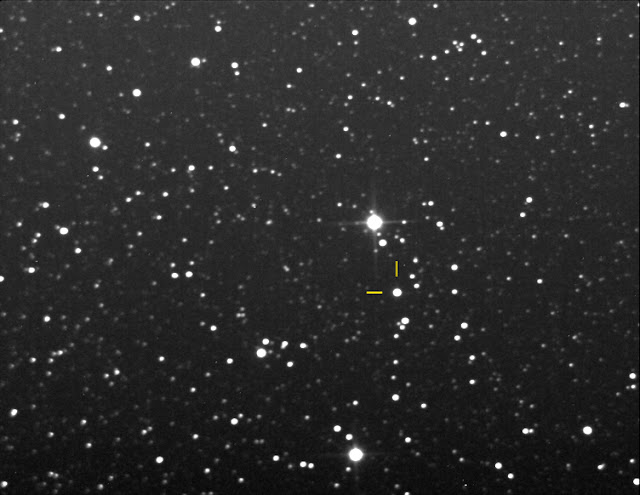Vend47: a new symbiotic variable in Sagitta
Update: symbiotic nova outburst of Vend47 (=V426 Sge) detected in 1968.
Vend47 was found on my 4x60s DSLR images of my "QW Sge" field made Canon EOS 1000D camera with 180mm focus telephoto lens in Zsámbék, Hungary. The star was 12.0TG on 31.9451 July and 11.66TG on 3,9886 Aug. and 10.7TG on 08.9381 Aug. VSX listed an SR variable ASASSN-V J195442.95+172212.6 with a range between 12.16-12.84V with 418 days period. ASAS-SN data show a sudden rise from 12.025C on 05.49 August to 11.113V on 06.3317 Aug -- a strange fast brightening for an SR variable with 418 days period. So I suggested it was a symbiotic variable in outburst when it was submitted to the IAU Central Bureau for Astronomical Telegrams Transient Object Confirmation Page (TOCP) as a new discovery where it was designated TCP J19544251+1722281.
CCD observations by Tamás Tordai (Budapest, Hungary) using a 0.25m reflector on August 09.815 UT confirmed the outburst at 10.85V.
After the ARAS community has been alerted by Péter Somogyi (Hungary), a low resolution spectrum obtained by Paolo Beradi (Italy) on 2018 Aug. 09.840 UT showed hydrogen and helium in emission, indicative of a symbiotic outburst.
Spectroscopy obtained by U. Munari et al. on 2018 Aug 10.855 UT with the Asiago 1.22m telescope and on Aug 10.882 UT with the Varese 84cm indicates the object is "a previously unknown symbiotic binary, currently undergoing an "hot-type" outburst, with the wind of the cool giant being increasingly ionized by a hot companion rising in Teff." Comparing with APASS mean values for quiescence, B=13.798 and V=12.637, the object is now 2.3 mag brighter in B and far bluer in color (from B-V=+1.16 to +0.53). (More details in ATEL #11937: HBHa 1704-05: a bright and newly discovered symbiotic star, currently undergoing an "hot-type" outburst)
Finally I managed to observe Vend47 visually at the MTT 2018 Astronomer Camp ,Tarján, Hungary on Aug. 11.986 UT using a 8cm refractor of László Juhász. I estimated 11.0v, whereas László estimated 11.1v. Recent AAVSO observations show that the brightening of Vend47 has stopped.
On 14 August AAVSO issued Alert Notice 648: Semiregular variable reclassified as symbiotic: outburst of ASASSN-V J195442.95+172212.6 = Vend47 (Sge)
Observations of all types (visual, CCD, DSLR, PEP, spectroscopy) and multiple bands as instrumentation permits are strongly encouraged as the outburst progresses.
Vend47 is located ~1.5 south from the gobular cluster M71 in the asterism Lorezin 4, so it is a nice target even for deep sky observers.
UPDATE: Vend47 has also been observed in two UV bands and detected by the X-ray space telescope of Neil Gehrels Swift Observatory on 28 August 2018. (ATEL #11997)
* * *
Update2:
Historical photographic light curve reveals no symbiotic-like activity from ~1900 to 1967. In 1968, V426 Sge experienced a symbiotic nova eruption that ceased around 1990. From approximately 1972, a wave-like orbitally related variation with a period of 493.4 ± 0.7 days developed in the light curve. This was interrupted by a Z And-type outburst from the beginning of August 2018 to the middle of February 2019 (2020A&A...636A..77S).
* * *
The "Vendégcsillag-kereső" /Guest Star Hunter/ Programme originally initiated by me as a nova-patrol program. In the last 7.5 years of this programme we discovered ~47 new variables so far, but Vend47 is the first real transient, a symbiotic variable.)
The full list of new variable stars discovered by the "Vendégcsillag-kereső" team.










Megjegyzések
Megjegyzés küldése